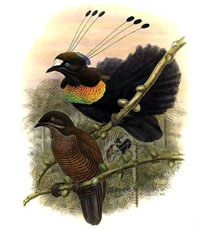Paradijsvogel verleidt vrouwtje met boemerangvormige borstveren

Paradijsvogelmannetjes hebben borstveren waarvan de kleinste vertakkingen boemerangvormig zijn. Door deze speciale vorm kunnen de vogels hun borst razendsnel van kleur laten veranderen, ontdekte de Groningse hoogleraar biofysica Doekele Stavenga. Paradijsvogels gebruiken deze techniek om indruk te maken op de vrouwtjes. De resultaten van het onderzoek zijn in december gepubliceerd door het wetenschappelijke tijdschrift Proceedings of the Royal Society B.
Stavenga bestudeerde samen met Australische en Britse collega’s veren van de paradijsvogel, Parotia lawesii, die leeft in Nieuw-Guinea. De mannetjes van deze soort zijn beroemd vanwege hun opvallend gekleurde borstveren die plotseling drastisch van kleur kunnen veranderen: van geel naar blauw, oranje of groen. Een versiertruc die de mannetjes toepassen in hun paringsdans.
Boemerang
De wetenschappers ontdekten dat de flitsende kleurveranderingen te danken zijn aan de structuur van de zogenaamde baardjes in de veer: microscopisch kleine vertakkingen van de zogenaamde baarden van de veerschacht. Bij normale vogelveren is de doorsnede van deze baardjes plat ovaal, bij paradijsvogels bleken ze gekromd, net als een boemerang.
Razendsnelle kleurverandering
Juist de boemerangvorm is het geheim achter het kleurenspel van de paradijsvogel, zegt Stavenga: 'De veer werkt als een drievoudige spiegel. In het midden van de boemerangvorm reflecteert het baardje oranje, aan de zijkanten blauw. Door de veer iets te kantelen verandert het spectrum en wordt het gereflecteerde licht ineens geel, groen of paars.'
Elliptische spiegel
Aan de basis van de ontdekking ligt een door de Groningse biofysici ontwikkelde meetopstelling, een imaging scatterometer, waarmee de verstrooiing van het licht dat op een object valt in één keer vanuit alle hoeken wordt gemeten. 'We maken hiervoor gebruik van een elliptische spiegel', zegt Stavenga. 'Tot nu toe werden dit soort metingen slechts vanuit enkele hoeken gedaan. Met deze unieke opstelling kunnen we direct de lichtverstrooiing over de gehele 180-graden afbeelden.'
Pauwen
Ook andere vogels zoals pauwen, duiven en spreeuwen bezitten veren die van kleur kunnen veranderen. Maar deze kleurovergangen, die afhankelijk zijn van de inkijkhoek, zijn veel minder abrupt dan die van de paradijsvogel. 'De baardjes van de meeste vogelveren bestaan uit laagjes melanine omringd door keratine die werken als een meerlaagse spiegel', legt Stavenga uit. 'Door iridiscentie krijgen de vogelveren zo een groene of blauwe kleur. Maar flitsende kleurovergangen zoals bij de paradijsvogel bereik je hier niet mee.'
Paringsdans
De plotselinge kleurveranderingen van de borstveren zijn onderdeel van het bijzondere paringsritueel van de paradijsvogel. De eerste stap in de uitgebreide paringsdans is het vrijmaken van de 'dansvloer': het mannetje verwijdert losslingerende bladeren en takjes van het stuk grond waar hij zijn dans gaat opvoeren en roept ondertussen de vrouwtjes. De vrouwelijke paradijsvogels kijken vervolgens toe hoe het mannetje zijn dans opvoert, waarbij de man hevig met zijn borst schudt, waardoor de borstveren continue van kleur verschieten.
Verleidingstechniek
De boemerangvormige baardjes lijken een evolutionaire aanpassing van de normale veer om sterke kleurveranderingen te produceren, zegt Stavenga. 'Voor ons als mensen ziet het er prachtig uit, maar we weten natuurlijk niet hoe de vrouwelijke paradijsvogels het kleurenspel precies zien. Het is echter overduidelijk dat de plotselinge kleurovergangen een belangrijke verleidingstechniek van de mannetjesparadijsvogels zijn.'
Meer informatie: prof. dr. Doekele G. Stavenga, tel. 050-363 4785, e-mail d.g.stavenga rug.nl
Artikel: Dramatic colour changes in a bird of paradise caused by uniquely structured breast feather barbules. Auteurs: Doekele G. Stavenga, Hein L. Leertouwer, N. Justin Marshall en Daniel Osorio. Proceedings of the Royal Society B. 15 december 2010. (http://rspb.royalsocietypublishing.org/content/early/2010/12/11/rspb.2010.2293.full)
Bron afbeelding: Painting of Parotia lawesii by Richard Bowdler Sharpe (upper, male; lower, female) (http://en.wikipedia.org/wiki/File:Parotia_lawesii_by_Bowdler_Sharpe.jpg)
YouTube filmpje: paradijsvogelmannetje voert paringsdans uit (David Attenborough): http://www.youtube.com/watch?v=cEh-zclVo44
Filmpje uit het artikel waarop kleurverandering goed zichtbaar is (bron: Macaulay Library, Cornell University): https://macaulaylibrary.org/video/45933
Zie ook. http://www.newscientist.com/blogs/shortsharpscience/2010/12/paradise-bird-shows-off-clever.html
Meer nieuws
-
18 december 2025
Waarom innoveren, en voor wie?
-
17 december 2025
Ben Feringa wint Feynmanprijs
-
16 december 2025
FEBS Excellence Award 2025 for Alexander Belyy
